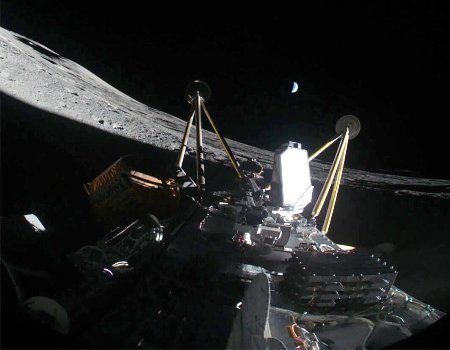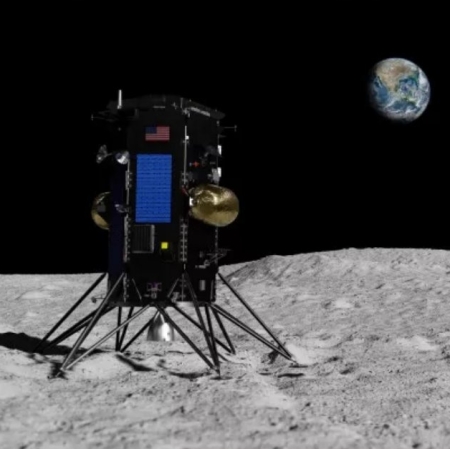Intuitive Machines confirms Athena fell over at landing; ends mission


Intuitive Machines today officially ended its Athena lunar lander mission after it released a picture taken from the top of the lander showing clearly that it had fallen over on its side after landing.
That picture, cropped, reduced, and brightened to post here, is to the right. You can clearly see two of the landing legs in the air, with the horizon in the background.
“With the direction of the sun, the orientation of the solar panels, and extreme cold temperatures in the crater, Intuitive Machines does not expect Athena to recharge,” the company stated. “The mission has concluded and teams are continuing to assess the data collected throughout the mission.”
This is the second Intuitive Machines lunar lander to tip over. More and more it does appear that the tall design of this lander is fundamentally flawed. The artist rendering to the right illustrates this. Most unmanned lunar landers are much wider than they are tall. Intuitive Machines’ Nova design has the lander’s height matching the spread of its legs. It creates a center of gravity high enough that the lander will tip over too easily if conditions are not perfect.
The company denies this, saying the center of gravity is much lower than this graphic makes it appear, but the proof is in the pudding. Their design has tried to land on the Moon twice, and both times the lander tipped over.
It is not clear what the company can do to fix this. Expanding its diameter to lower its height is a major redesign. It also might make the lander too wide to fit inside most rocket fairings. A better solution might be to redesign the legs, making their spread wider, and even increasing their number.
Fortunately, NASA’s shift to capitalism in space has produced a number of different companies building lunar landers. Firefly’s Blue Ghost is clearly a success. In June Ispace will make its second attempt to soft land its private lander design on the Moon. And Astrobotic has a contract to try again after it had a fuel line leak after launch last year that prevented it from even attempting a landing.
And of course, Intuitive Machines is still in the game. It has a contract for one more landing mission, plus a mission to put two data relay satellites in lunar orbit.


Intuitive Machines today officially ended its Athena lunar lander mission after it released a picture taken from the top of the lander showing clearly that it had fallen over on its side after landing.
That picture, cropped, reduced, and brightened to post here, is to the right. You can clearly see two of the landing legs in the air, with the horizon in the background.
“With the direction of the sun, the orientation of the solar panels, and extreme cold temperatures in the crater, Intuitive Machines does not expect Athena to recharge,” the company stated. “The mission has concluded and teams are continuing to assess the data collected throughout the mission.”
This is the second Intuitive Machines lunar lander to tip over. More and more it does appear that the tall design of this lander is fundamentally flawed. The artist rendering to the right illustrates this. Most unmanned lunar landers are much wider than they are tall. Intuitive Machines’ Nova design has the lander’s height matching the spread of its legs. It creates a center of gravity high enough that the lander will tip over too easily if conditions are not perfect.
The company denies this, saying the center of gravity is much lower than this graphic makes it appear, but the proof is in the pudding. Their design has tried to land on the Moon twice, and both times the lander tipped over.
It is not clear what the company can do to fix this. Expanding its diameter to lower its height is a major redesign. It also might make the lander too wide to fit inside most rocket fairings. A better solution might be to redesign the legs, making their spread wider, and even increasing their number.
Fortunately, NASA’s shift to capitalism in space has produced a number of different companies building lunar landers. Firefly’s Blue Ghost is clearly a success. In June Ispace will make its second attempt to soft land its private lander design on the Moon. And Astrobotic has a contract to try again after it had a fuel line leak after launch last year that prevented it from even attempting a landing.
And of course, Intuitive Machines is still in the game. It has a contract for one more landing mission, plus a mission to put two data relay satellites in lunar orbit.











